鬼塚雅
木村葵来
Miyabi Onitsuka / Kira Kimura
Doing their utmost to reach the pinnacle
Taking on the challenge of the global arena
June 19, 2024
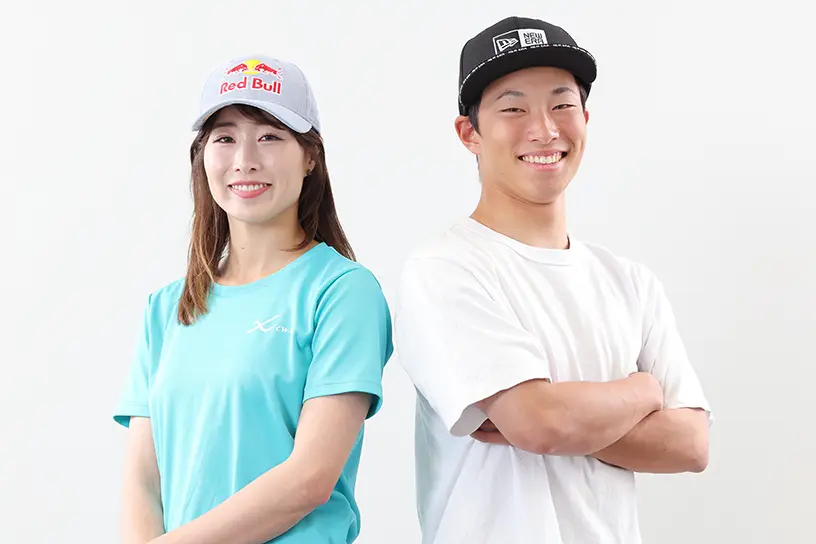
Interview: Takaya Hirano / Photos: Shinichi Shimazaki
Reaching for the pinnacle of snowboarding, inspired by their environment
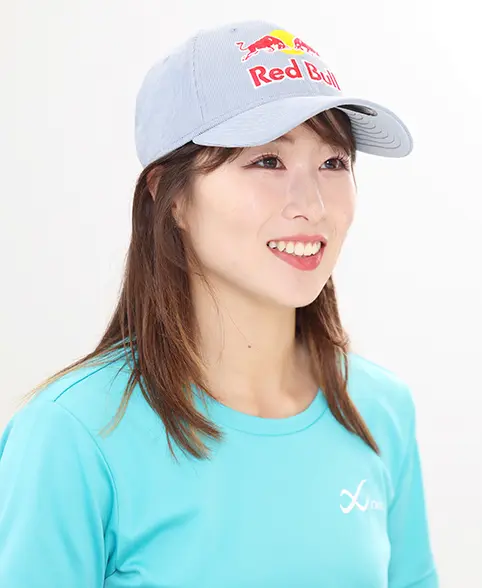
- ITO: What inspired you to start snowboarding?
-
Onitsuka: When I was five, my family traveled from Kumamoto to Fukuoka on vacation. It was raining and there was nothing to do, so we went to an indoor snow park. That's how I came across snowboarding for the first time. There weren't many small children there, so everyone was kind to me. I had a great time.
Kimura: My father snowboarded for fun. He took me from Okayama to the ski slopes in Tottori, where I’d play in the snow with his friends and acquaintances. That's where I learned how to snowboard naturally. I think I was around four at the time.
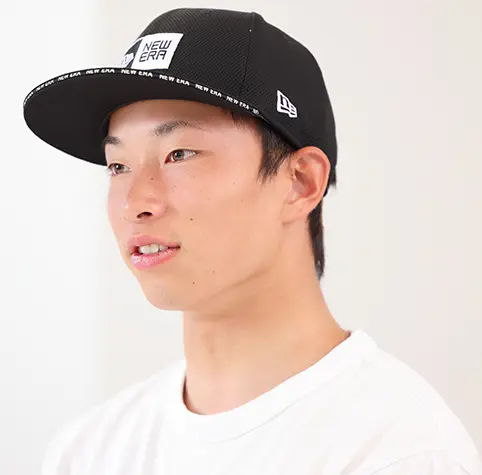
- ITO: How did you get started snowboarding competitively?
-
Onitsuka: I think my environment shaped the desire to become a pro. The slopes I visited in Fukuoka Prefecture had rails. That might have been rare back then. Everyone was doing it, so I wanted to give it a try, too. In time, with support from my sponsor, I entered the primary tournament. Then I advanced to the international tournament, called the Pro Series. I was the first Japanese female to make it that far.
Kimura: The slopes I went to in Tottori also had jump ramps and rails. I started to think about becoming a competitive snowboarder around the first year of middle school. In elementary school, I participated in apparatus gymnastics and attended trial lessons for the competitive training course at a company team. I practiced from late afternoon through evening six days a week. It was kind of a drag. [laughs] I enjoyed snowboarding more. Then I saw on TV that snowboarding had been accepted as a competitive event for a global athletic tournament. It fascinated me and I wanted to give that a try.

- ITO: What do you find so appealing about snowboarding?
-
Onitsuka: I like how there are so many different ways to have fun with it. On my own, it's fun to master the finer techniques. It's fun just to snowboard with others, even if you don’t have the right technique. I think it's great how many different ways you can enjoy doing it.
Kimura: I'm attracted by its dynamism. When you’re watching a competition, it's hard to believe the boarders can move so freely they can come to a landing even with their feet stuck on the boards. That's something impossible to do on the first attempt. I think it's the magnificence of snowboarding, something you can’t understand until you try it yourself, that attracts me to the sport.
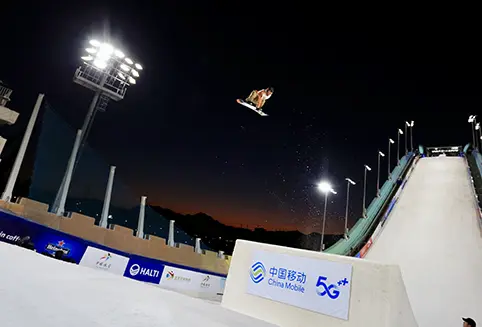
Photo credit: Ski Association of Japan
- ITO: Both of you compete in the two events of slopestyle and big air. Why did you choose them?
-
Onitsuka: I think I drifted toward those events just because of my environment at the time. Even now, most ski areas have slopes and ramps, so those are the two easiest events to have access to. Not many ski areas have halfpipes or courses for alpine or cross.
Kimura: I’ve loved jumping around since my years as a gymnast. The ski area I went to didn’t have a halfpipe, so I’d jump off the ramp. I think my experience with gymnastics gave me the skills you need to adjust in midair, which helps in making decent landings from a jump even if you slip up on takeoff.
-
Onitsuka: I love how Kira can make a daring landing in competitions even if he can’t do it in open practice just before. Kira could do it even when we were just playing around using the rails to move in unorthodox ways on the final day of the tournament. I'm impressed by his control when his body is airborne.
Kimura: I think I just move my body in the air to match the landing I picture in my head. But I’d really like to jump as high as the snowboarders from other countries. My heights are pretty good for Japan, and I want to jump higher than everybody else in the big air events.
The key is to balance training and recovery.
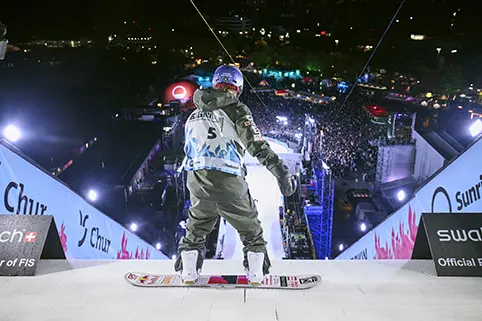
Photo credit: Ski Association of Japan
- ITO: Snowboarding is a winter sport. What do you do all year long?
-
Onitsuka: The season starts around October. I compete in about ten tournaments a year. During the summer off-season, from June to August or so, I train on a dry slope. First, I participate in tournaments in New Zealand, where the seasons are opposite ours, then I return to Japan and make adjustments before the international tour begins. Basically, in the off-season, I acquire the techniques I’ll use in competitions. During the season, I keep working on them in the time off between tournaments as well.
-
Kimura: Once the season starts, I don’t practice new techniques all that much. My main training during the season is focused on conditioning.
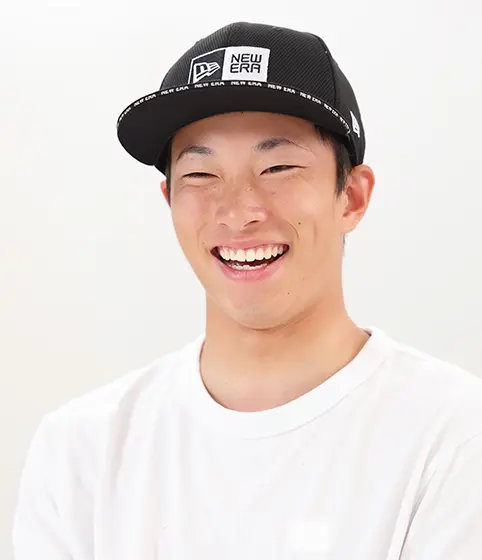
- ITO: Rather than just practicing technique, you also do conditioning during the off season. What points do you focus on?
-
Onitsuka: I do strength training twice a week. Until recently, I thought strength training would make me less mobile and too heavy. But, sometimes, if you weigh too little, you can’t spin adequately after jumping. I’ve gained eight kilos since 2023, and I’m in good shape. My ride feels stable, and my landings are stable. I'm thinking about adding another two kilos.
Time off is important, too. I work on my technique over and over again on a dry slope, which wears me out about as much as strength training. Until the world tournament in 2022, I trained seven days a week. Now I make sure to take one day a week off, no matter how anxious I am to work on my technique.
-
Kimura: I’m a university student and can’t snowboard on the weekdays, so I focus on training during the off-season. But it feels like building too much muscle makes it harder to make the moves I want to make. I think building too much muscle had something to do with my lower back pain. So, for these reasons, I keep my strength training fairly minimal, once every one or two weeks. I do aerobic work fairly consistently. Since I don’t have much stamina compared to other snowboarders, I run or bike in the mornings.
- ITO: Do you do anything special to stay in top form?
-
Onitsuka: I think all the time about how fast I can recover, and visualize this as something like the strength bar in a one-on-one combat video game. I think recovery is important because it determines what kind of training I can do the next day. It's also important to sleep well, to go to bed at the same time every night. I use care goods, and I stretch before going to bed. I’m also pretty fussy about my bed and pillows.
Kimura: I want to snowboard in my best condition, so I follow a relaxation routine before going to sleep. I take a compact roller with me on road trips so I can stretch on my own. Right now, I only have time to stretch for about 30-60 minutes before going to bed. I try to make it a habit so I can get a better grip on my physical condition. Before, I didn’t pay enough attention to stretching and warmups. But since my surgery for a dislocated shoulder, I’ve been paying more attention to my conditioning.
Treatment devices can provide peace of mind in competitions that often lead to injuries.
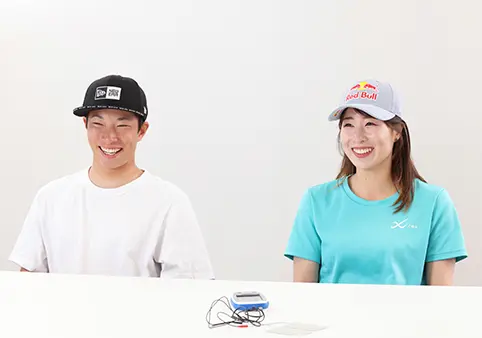
- ITO: What prompted you to start using treatment devices?
-
Onitsuka: I started when I was around 12, after having surgery for a broken collarbone. My mother kept pestering the doctors to find out what would help me heal faster. They told her about ultrasound therapy. I was pretty worried, because the injury meant I couldn’t train. Treatment devices helped me to focus on rehabbing. It didn’t just help me heal faster, it helped maintain my motivation. I think that’s a really good point.
-
I attracted a lot of media attention when I won the World Championships at the age of 15, but I was actually working around an injured medial ligament in my left leg at that time. I was treating it using a low-frequency electrotherapy device loaned by a bonesetter's clinic we knew. I liked the portability and the results, so I bought one myself. I’ve used it ever since. Snowboarding tends to lead to numerous injuries, including bruises. I wouldn't feel comfortable not having my treatment devices.
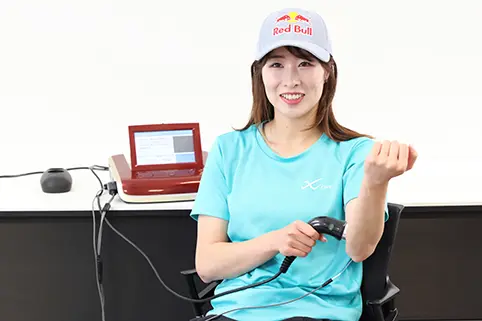
- ITO: We've heard that you know a lot about treatment devices, Ms. Onitsuka. What kinds of devices are you currently using?
-
Onitsuka: You have to draw on your entire body when you’re working on technique. So your muscles tend to get tense. If they’re so tense that sleep doesn’t do much and warming up is no longer enough to relax, I prepare for training using a combination therapy device and a high-voltage electrotherapy device, which loosen up the muscles around the shoulder blades and the neck. I use microcurrent therapy to treat bruises. You don't feel anything, so you can do it while doing something else. I’ll use it while using my smartphone or while my trainer is working on another area of my body. Being able to do two things at once helps the recovery go faster. Sometimes I forget I'm even using it until it beeps to tell me it's finished. [laughs]
-
Sometimes, I use an ultrasound therapy device to warm up my muscles. It's much more effective in stretching my muscles after warming up. It feels like the stretching goes deep into the muscles. I also use it to improve blood circulation in my legs. I use it on my arms, too, because they can start to ache after carrying a snowboard for a long time.

- ITO: What prompted you to start using treatment devices, Mr. Kimura?
-
Kimura: I started using treatment devices when I began competing internationally as a member of the Japan National Team. At a tournament in New Zealand in 2023, my lower back started to ache. It was so bad I could hardly walk. My trainer told me to apply microcurrent for a whole day using an electrotherapy device. As I kept getting the therapy in my room, it was pretty easy to sense the day to day improvements. After a week, I found I could resume my training.
-
Also, when my body isn’t used to the altitude right after I arrive at a competition venue overseas, I tend to come down with a case of stiff muscles and swelling. Using the treatment devices can make it easier just to move around in such a case.
Gunning for the winner's podium in new challenges
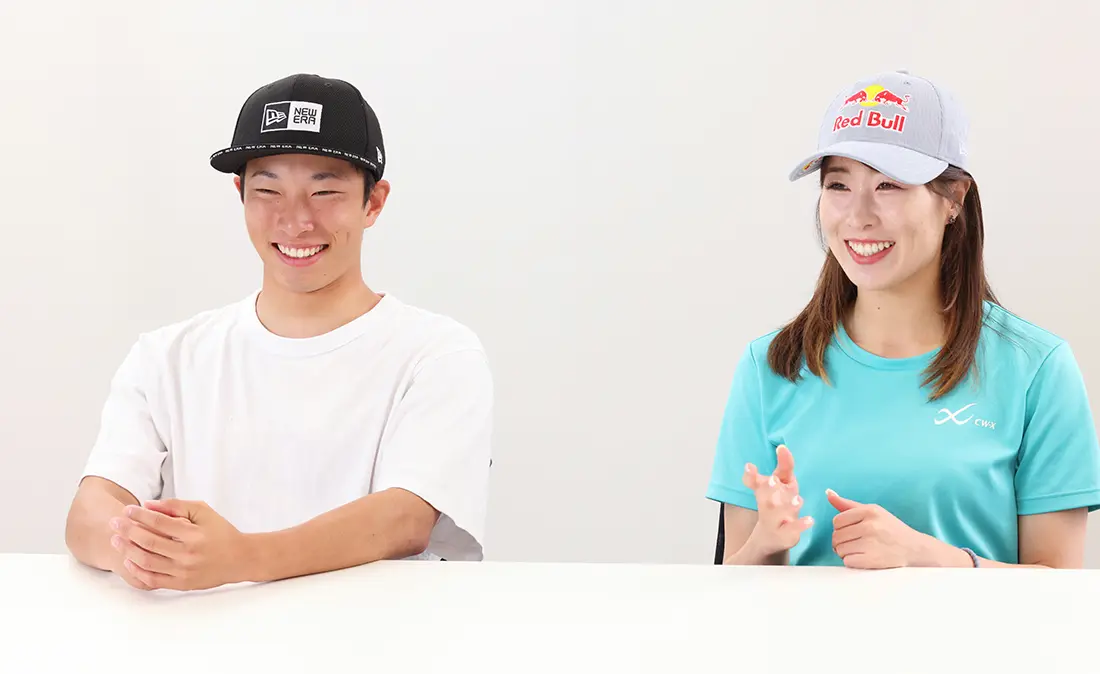
- ITO: In conclusion, can you tell us about your future goals?
-
Onitsuka: I'm working on a new technique, the triple cork 1440—that’s three vertical and four horizontal rotations on an inclined axle, preparing for the World Championships in Switzerland in March 2025 to win a medal. My biggest goal is to return to the world athletic tournament and win a medal.
Kimura: My first goal is to do my best all season, injury-free. In tournaments, I want to focus on climbing steadily up the ranks by winning the preliminary rounds. Tournaments mostly involve techniques with relatively high rates of success, rather than the ones that are highly challenging, but it's surprisingly difficult to maintain a high score. But once you make it to the final round, you can win it all! [laughs] Some big air events overseas draw tens of thousands of spectators. I love that atmosphere. Last season, I became an annual champion of the big air events. Japanese snowboarders are said to be weak on the slopes. My goal is to compete against really creative international snowboarders to secure a spot on the winner's podium of the slopes as well. I want to make it to that podium in every tournament this season.
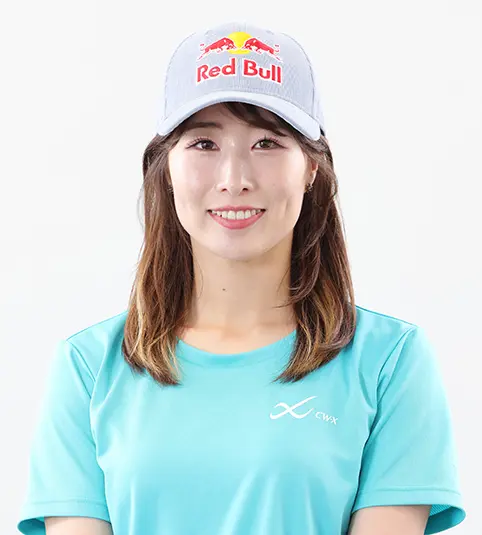
Born October 12, 1998 in Kumamoto Prefecture.
Affiliated with ISPS.
Active since childhood in Japan and overseas; began snowboarding at five, winning her first-ever tournament as a first grader. Won the women's slopestyle event at the 2015 Snowboarding World Championships at the age of 16 years and three months—the youngest ever for either males or females.
Placed eighth in the women's big air event at the 2018 Winter Olympics in Pyeongchang. Won the women's big air event at 2020 X Games Aspen in Aspen, USA. Stood on a podium both taking third place in the slopestyle and second place in the big air event in the 2023 World Championships.
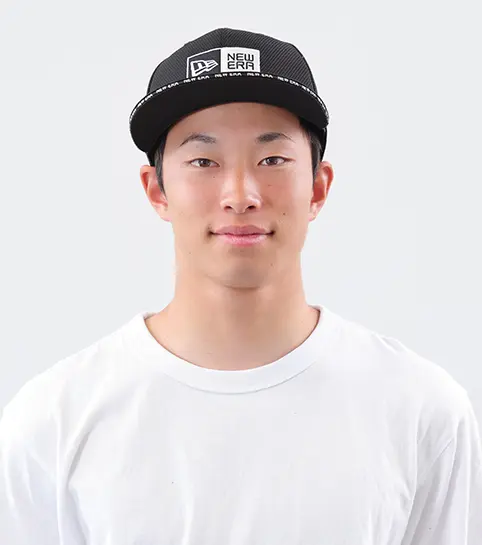
Born June 30, 2004 in Okayama Prefecture.
Affiliated with Murasaki Sports
Went pro in the eighth grade despite a relatively late start with full competition (seventh grade) and has gone on to win numerous tournaments since.
Gave a remarkable performance in the big air event of the Snowboarding World Cup in the 2023-24 season, taking second place in the first tournament, third in the second, and fifth in the third, emerging as overall winner of the event. Led the field all year in the big air event.
Won third place in the big air event at the Asia Cup in 2024, taking first place in slopestyle and second place in big air at the All Japan Snowboarding Championships and second place in slopestyle at the European Cup.
